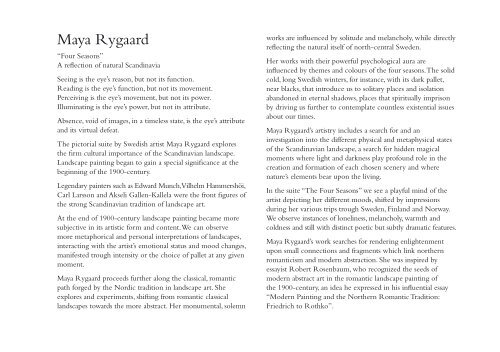Paisajes -- Landscapes - Rygaard, Maya
Paisajes -- Landscapes - Rygaard, Maya
Paisajes -- Landscapes - Rygaard, Maya
You also want an ePaper? Increase the reach of your titles
YUMPU automatically turns print PDFs into web optimized ePapers that Google loves.
<strong>Maya</strong> <strong>Rygaard</strong><br />
“Four Seasons”<br />
A reflection of natural Scandinavia<br />
Seeing is the eye’s reason, but not its function.<br />
Reading is the eye’s function, but not its movement.<br />
Perceiving is the eye’s movement, but not its power.<br />
Illuminating is the eye’s power, but not its attribute.<br />
Absence, void of images, in a timeless state, is the eye’s attribute<br />
and its virtual defeat.<br />
The pictorial suite by Swedish artist <strong>Maya</strong> <strong>Rygaard</strong> explores<br />
the firm cultural importance of the Scandinavian landscape.<br />
Landscape painting began to gain a special significance at the<br />
beginning of the 1900-century.<br />
Legendary painters such as Edward Munch, Vilhelm Hammershöi,<br />
Carl Larsson and Akseli Gallen-Kallela were the front figures of<br />
the strong Scandinavian tradition of landscape art.<br />
At the end of 1900-century landscape painting became more<br />
subjective in its artistic form and content. We can observe<br />
more metaphorical and personal interpretations of landscapes,<br />
interacting with the artist’s emotional status and mood changes,<br />
manifested trough intensity or the choice of pallet at any given<br />
moment.<br />
<strong>Maya</strong> <strong>Rygaard</strong> proceeds further along the classical, romantic<br />
path forged by the Nordic tradition in landscape art. She<br />
explores and experiments, shifting from romantic classical<br />
landscapes towards the more abstract. Her monumental, solemn<br />
works are influenced by solitude and melancholy, while directly<br />
reflecting the natural itself of north-central Sweden.<br />
Her works with their powerful psychological aura are<br />
influenced by themes and colours of the four seasons. The solid<br />
cold, long Swedish winters, for instance, with its dark pallet,<br />
near blacks, that introduce us to solitary places and isolation<br />
abandoned in eternal shadows, places that spiritually imprison<br />
by driving us further to contemplate countless existential issues<br />
about our times.<br />
<strong>Maya</strong> <strong>Rygaard</strong>’s artistry includes a search for and an<br />
investigation into the different physical and metaphysical states<br />
of the Scandinavian landscape, a search for hidden magical<br />
moments where light and darkness play profound role in the<br />
creation and formation of each chosen scenery and where<br />
nature’s elements bear upon the living.<br />
In the suite “The Four Seasons” we see a playful mind of the<br />
artist depicting her different moods, shifted by impressions<br />
during her various trips trough Sweden, Finland and Norway.<br />
We observe instances of loneliness, melancholy, warmth and<br />
coldness and still with distinct poetic but subtly dramatic features.<br />
<strong>Maya</strong> <strong>Rygaard</strong>’s work searches for rendering enlightenment<br />
upon small connections and fragments which link northern<br />
romanticism and modern abstraction. She was inspired by<br />
essayist Robert Rosenbaum, who recognized the seeds of<br />
modern abstract art in the romantic landscape painting of<br />
the 1900-century, an idea he expressed in his influential essay<br />
“Modern Painting and the Northern Romantic Tradition:<br />
Friedrich to Rothko”.


